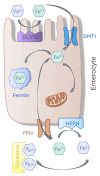Enhanced CRC Growth in Iron-Rich Environment, Facts and Speculations
- PMID: 39596454
- PMCID: PMC11594836
- DOI: 10.3390/ijms252212389
Enhanced CRC Growth in Iron-Rich Environment, Facts and Speculations
Abstract
The contribution of nutritional factors to disease development has been demonstrated for several chronic conditions including obesity, type 2 diabetes, metabolic syndrome, and about 30 percent of cancers. Nutrients include macronutrients and micronutrients, which are required in large and trace quantities, respectively. Macronutrients, which include protein, carbohydrates, and lipids, are mainly involved in energy production and biomolecule synthesis; micronutrients include vitamins and minerals, which are mainly involved in immune functions, enzymatic reactions, blood clotting, and gene transcription. Among the numerous micronutrients potentially involved in disease development, the present review will focus on iron and its relation to tumor development. Recent advances in the understanding of iron-related proteins accumulating in the tumor microenvironment shed light on the pivotal role of iron availability in sustaining pathological tumor hallmarks, including cell cycle regulation, angiogenesis, and metastasis.
Keywords: colorectal cancer; intestinal microbiota; iron metabolism.
Conflict of interest statement
The authors declare no conflicts of interest.
Figures


Similar articles
-
Metabolic Reprogramming of Colorectal Cancer Cells and the Microenvironment: Implication for Therapy.Int J Mol Sci. 2021 Jun 10;22(12):6262. doi: 10.3390/ijms22126262. Int J Mol Sci. 2021. PMID: 34200820 Free PMC article. Review.
-
Role of dietary nutrients and metabolism in colorectal cancer.Asia Pac J Clin Nutr. 2024 Jun;33(2):153-161. doi: 10.6133/apjcn.202406_33(2).0002. Asia Pac J Clin Nutr. 2024. PMID: 38794975 Free PMC article. Review.
-
Effects of nutrients (in food) on the structure and function of the nervous system: update on dietary requirements for brain. Part 1: micronutrients.J Nutr Health Aging. 2006 Sep-Oct;10(5):377-85. J Nutr Health Aging. 2006. PMID: 17066209 Review.
-
Hallmarks in colorectal cancer: angiogenesis and cancer stem-like cells.World J Gastroenterol. 2014 Apr 21;20(15):4189-96. doi: 10.3748/wjg.v20.i15.4189. World J Gastroenterol. 2014. PMID: 24764657 Free PMC article. Review.
-
Immune System, Microbiota, and Microbial Metabolites: The Unresolved Triad in Colorectal Cancer Microenvironment.Front Immunol. 2021 Mar 26;12:612826. doi: 10.3389/fimmu.2021.612826. eCollection 2021. Front Immunol. 2021. PMID: 33841394 Free PMC article. Review.
Cited by
-
Decoding the Tumor-Associated Microbiota: From Origins to Nanomedicine Applications in Cancer Therapy.Biology (Basel). 2025 Feb 27;14(3):243. doi: 10.3390/biology14030243. Biology (Basel). 2025. PMID: 40136500 Free PMC article. Review.
-
Mesalazine and Lactoferrin as Potential Adjuvant Therapy in Colorectal Cancer: Effects on Cell Viability and Wnt/β-Catenin Pathway.Curr Issues Mol Biol. 2025 May 2;47(5):327. doi: 10.3390/cimb47050327. Curr Issues Mol Biol. 2025. PMID: 40699726 Free PMC article.
References
-
- Ross A.C., Caballero B., Cousins R.J., Tucker K.L. Modern Nutrition in Health and Disease. Jones & Bartlett Learning; Burlington, MA, USA: 2020.
-
- Bothwell T.H., Finch C.A. Iron Metabolism. Little, Brown & Co.; Boston, MA, USA: Toronto, ON, USA: 1962. p. 339.
Publication types
MeSH terms
Substances
Grants and funding
LinkOut - more resources
Full Text Sources
Medical

